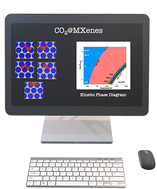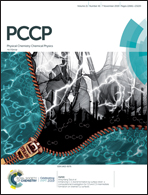Thickness biased capture of CO2 on carbide MXenes†
Abstract
The synthesis of two-dimensional transition metal carbides (MXenes) with a predefined number of atomic layers offers a possible way to tune these nanomaterials chemical activity. MXenes have been theoretically predicted to be able to store CO2 even at high temperatures and low CO2 partial pressures, a prediction which has been experimentally confirmed afterwards. In the present work, the influence of the number of atomic layers on CO2 adsorption is systematically investigated by means of density functional theory based calculations, using suitable periodic models representing the (0001) surface of a series of these materials with formula Mn+1Cn (M = Ti, Zr, Hf, V, Nb, Ta, Mo, W) and n = 1–3. The interaction of CO2 with the MXene surfaces is always favorable with the adsorption energy decreasing as the transition metal electronic configuration goes from d2 through d3 to d4, in agreement with previous work for n = 1. The influence of the thickness is found to be rather small, yet noticeable, although somewhat erratic. Nevertheless, the adsorption energy seems to converge to a defined clear limit for sufficiently thick MXenes. Interestingly, this value is close to that corresponding to the (111) surface of bulk Transition Metal Carbides (TMCs). The close structural similarity between the MXene (0001) and TMC (111) surfaces strongly suggests that the former provide a practical way to approach this otherwise unstable surface. The possibility to tune the CO2 interaction based on the MXene thickness is further investigated by means of kinetic phase diagrams. These provide additional evidence that carbide MXene surfaces are promising materials for CO2 capture even at low CO2 partial pressures, and that the MXene thickness can be used to fine tune this appealing behavior.



 Please wait while we load your content...
Please wait while we load your content...